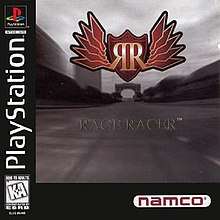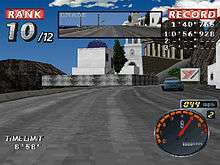Rage Racer
| Rage Racer | |
|---|---|
 | |
| Developer(s) | Namco |
| Publisher(s) |
Namco SCEE (Europe) |
| Composer(s) |
Tetsukazu Nakanishi Hiroshi Okubo |
| Series | Ridge Racer |
| Platform(s) | PlayStation |
| Release | |
| Genre(s) | Racing |
| Mode(s) | Single-player |
Rage Racer (レイジレーサー Reiji Rēsā) is the third title in the Ridge Racer series of racing games on the PlayStation. Developed and published by Namco, it was released in Japan on 3 December 1996.
Gameplay

Visually the game takes a different approach compared to previous PlayStation titles. The game looks more realistic and has a darker color scheme. It takes a lot of this from the arcade game in the Ridge Racer series, Rave Racer. For the first time in the Ridge Racer series, there is an advanced singleplayer career system which uses credits. The player can get credits from winning races which can then be used to buy and upgrade cars. The racing is separated into five classes, named 'Class 1' through to 'Class 5'. The object is to earn money (credits, or 'eg'), which can be spent on new cars or on upgrading existing cars.[1] The player must place in the top three in all of each class's events to progress to the next class. The player can make three attempts within each class to enter the top three spots of a race. If the player wins all three races in a class using the correct grade of car (e.g., a Grade 1 car in Class 1), the gold trophy for that class is earned. Otherwise, the player simply moves on to the next class. When the player has completed the five 'Normal GP' events, the 'Extra GP' is unlocked.[1] This allows the player to race the same classes on reversed courses. As well as unlocking the Extra GP, the player receives 999,999,999 e.g. in Normal GP - more than enough to purchase all of the cars and upgrade them to Grade 5.
Upon finishing Class 5 in the Extra GP, Class 6 is unlocked, along with the three 'secret' cars. Although it's in the Extra GP, the races in Class 6 are driven on the forward tracks. Class 6 features only four opponents rather than the eleven faced in all other classes.[2]
There are four car manufacturers in Rage Racer. Each of the four manufacturers favors a different attribute (e.g., handling, acceleration, speed). All of the 'standard' cars can be upgraded, with the cost increasing greatly from one grade to the next. This is the first game in the series that permits the player to race with a truck, but it only comes with manual transmission.
Development
In an interview with the Namco development team, Nobuhisa Mikoda (Rage Racer game designer and project director) admitted that the game was "somewhat off series and aimed to pursue enjoyment in shift controlling".[3] Rage Racer was the first in the Ridge Racer series to feature a CGI animated introduction. Here the Ridge Racer "mascot girl" Reiko Nagase was introduced.[4] Composed by Tetsukazu Nakanishi and Hiroshi Okubo, it marked the beginning of Namco's new primary sound team after their former members began working with other companies doing production on games such as Street Fighter EX (1996) and Driving Emotion Type-S (2000). The former had previously worked on Ridge Racer Revolution.
The game was unveiled at the August 1996 Tokyo Game Show, at which point it had yet to be titled.[5]
Reception
| Reception | ||||||||||||||||||||||
|---|---|---|---|---|---|---|---|---|---|---|---|---|---|---|---|---|---|---|---|---|---|---|
| ||||||||||||||||||||||
Reviews for Rage Racer were positive, though generally mild. Critics widely approved of the use of more photo-realistic visuals than the previous games in the series,[7][9][10][12] though some complained that they were comparatively drab and lacking in color.[9][13] Comments on the game varied widely, but criticisms tended to focus on a lack of improvement over the previous games in what the reviewers saw as key areas. For example, a Next Generation critic summed up, "Ridge Racer games have never been deficient in gameplay or graphics, and Rage Racer is the best of the lot, but this third incarnation still lacks the depth and replay value that can only be satisfied by finally knuckling down and giving players more tracks."[12] IGN concluded, "It's not a bad game, we've just seen it all before (and before that even)".[10] Jeff Gerstmann of GameSpot criticized it for failing to improve upon the unrealistic crashes seen in previous installments, though he nonetheless described it as "an outstanding sequel".[9]
Kraig Kujawa and Dean Hager of Electronic Gaming Monthly both described Rage Racer as a dramatic improvement over the original Ridge Racer.[7] Major Mike of GamePro concluded that "Once you get over the game's initial lull, you will have plenty to rage about with this cool new Racer."[13] The Official PlayStation Magazine said that Namco had succeeded in developing their game even further, and praised the track and car count, before concluding "The pick-up-and-play experience of the original remains, only now there is more longevity because of the incentive to progress through the classes and upgrade to the fastest cars". The game reached number 5 in the UK sales chart.[14]
References
- 1 2 "Rage Racer: Namco's Long-awaited Sequel is Raging Along the Right Track". Electronic Gaming Monthly. No. 92. Ziff Davis. March 1997. p. 108.
- ↑ ナムコ公式ガイドブック レイジレーサー (in Japanese). Japan. 27 December 1996. 4907892080010.
- ↑ "Ridge Racer V: the definitive interview". Computer And Video Games. Retrieved 2007-05-17.
- ↑ Mielke, James (2006-09-14). "Reiko Nagase Feature". 1UP.com. Archived from the original on 2007-09-27. Retrieved 2007-05-15.
- ↑ "Tokyo Game Show '96: Japan Shows Off". Next Generation. No. 24. Imagine Media. December 1996. p. 16.
- ↑ Game Rankings staff. "Rage Racer Reviews". GameRankings. Retrieved 2007-05-14.
- 1 2 3 "Team EGM Sports: Rage Racer". Electronic Gaming Monthly. No. 94. Ziff Davis. May 1997. p. 116.
- ↑ "Rage Racer - PS". Game Revolution. 2004-04-06. Archived from the original on 2007-09-30. Retrieved 2007-05-14.
- 1 2 3 4 Gerstmann, Jeff (1997-05-20). "Rage Racer Review". GameSpot. Retrieved 2007-05-14.
- 1 2 3 "IGN: Rage Racer Review". IGN. 1997-05-19. Retrieved 2007-05-14.
- ↑ Rage Racer review, Official UK PlayStation Magazine, Future Publishing, July 1997, issue 21, page 99
- 1 2 3 "Finals: Rage Racer". Next Generation. No. 29. Imagine Media. May 1997. p. 148.
- 1 2 Major Mike (April 1997). "PlayStation ProReview: Rage Racer". GamePro. No. 103. IDG. p. 78.
- ↑ Official UK PlayStation Magazine, issue 23
External links
- Rage Racer at AllGame
- Rage Racer at MobyGames